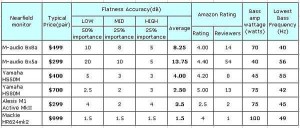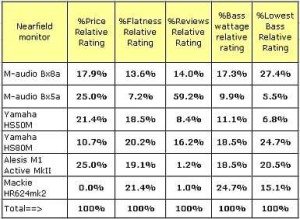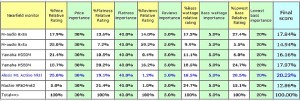If you are about to get started in home audio mixing or even mastering, one of the most important things that you should have is the high accurate near field studio/reference monitors. This also applies if you are already recording and mixing for some time and you feel the need to upgrade your studio monitors with much better quality at a better price. So what are the options? Most home studio producers are limited in budget.
They cannot afford to buy reference studio monitors more than $1000 or those that are used in commercial/big studios. This price is for the “pair” of monitors not each of them. So most of them are looking for near field monitors below $1000; however it’s very difficult to decide which near field monitor is best.
It is because this “best” can mean different from one person to another. Let’s assess the qualities of near field monitors based on the following measurable and important factors:
1.) Flatness Accuracy – the more flat is the response, the better will be the accuracy. This implies an “honest” studio reference monitor. What sounds good is really good and what sounds bad is really bad. Bear in mind that there are differences between a nearfield monitor and hi-fi monitors.
And also you need to learn why you should not mix using headphones. Headphones can’t tell you the truth and they do not have flat frequency response unlike nearfield monitors.
2.) Low Frequency Wattage rating – the stronger the better; an advantage when mixing rock, pop and hip-hop music where bass frequencies are important. Mixing with a subwoofer then is a very important requirement.
3.) Lowest supported bass frequency – the lower the better. A lower supported bass frequency will make it unnecessary for you to purchase an additional sub-woofer. You will save a lot of money and space in your home studio.
Other factors that determine the “qualities” of studio reference monitors are reviews rating and the number of reviewers. Let’s use Amazon.com review data. The higher the rating and the number of reviewers; the better will be the product reliability and performance.
The following are near field monitors with price below $1000 that creates significant buzz among home recording and mixing community. These are as follows:
1.) M-audio Bx8a
2.) M-audio Bx5a
3.) Yamaha HS50M
4.) Yamaha HS80M
5.) Alesis M1 Active MkII
6.) Mackie HR624mk2
Below are the raw data for each of the above reference monitors:
The Flatness accuracy is rated on LOW, MID and HIGH frequency range. Basically this is the “plus and minus error” of the frequency plot (if you view the frequency response graph of each monitors provided by the manufacturer) taken as absolute value.
The lower the value on the flatness accuracy in dB, the more accurate will be the near field monitors. It’s because the error is less and implies less fluctuations on the frequency response that will result to a flatter response.
I have assigned a 50% importance on the low frequency flatness because bass mixing accuracy is critical to any modern mix such as rock, pop, hip-hop and alternative music. User reviews from Amazon are also included where the highest possible rating is 5.
Bass amp wattage for the LF drivers is provided where the higher the value the more powerful will be the bass output. Lastly, the lowest bass frequency provided by their specifications is also important. The lower the bass frequency the better; it is because you will not need to purchase an additional sub-woofer to monitor the lower bass frequencies. Take note that the above data is not relative. Converting everything to a relative scale of 0% to 100%; here it is:
The higher the relative rating of each factor, the better will be the nearfield monitor performance on that factor alone. For example, Mackie HR624mk2 is rated 21.4% on %flatness which is the highest score in the %Flatness relative rating column.
This implies that this monitor has the best accurate response among the six monitors. But relative % data above is not yet analyzed for desirability for optimal usage. Supposing you will assign the following “importance” to your decision analysis:
Price= 30%
Flatness accuracy= 40%
Amazon rating=5%
Bass amp wattage= 5%
Lowest bass frequency= 20%
The following are the top 3 recommended reference monitors (by order of final score) with balance importance on price and accuracy while having a lower bass frequency limit:
1.) Alesis M1 Active MkII = 20.23%
2.) Yamaha HS80M = 17.97%
3.) M-audio Bx8a =17.84%
Score computation:


